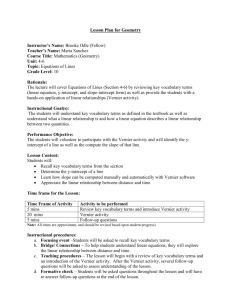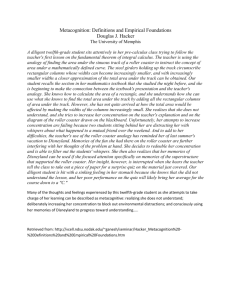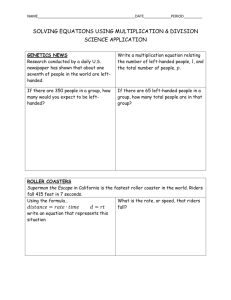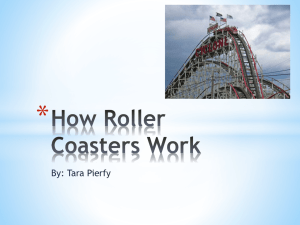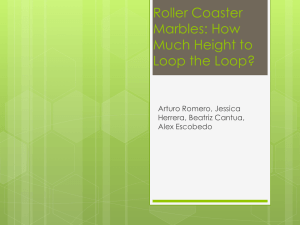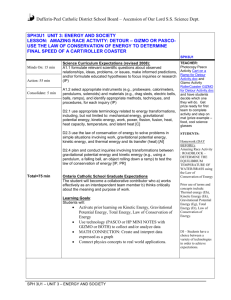Evaluation Procedure
advertisement
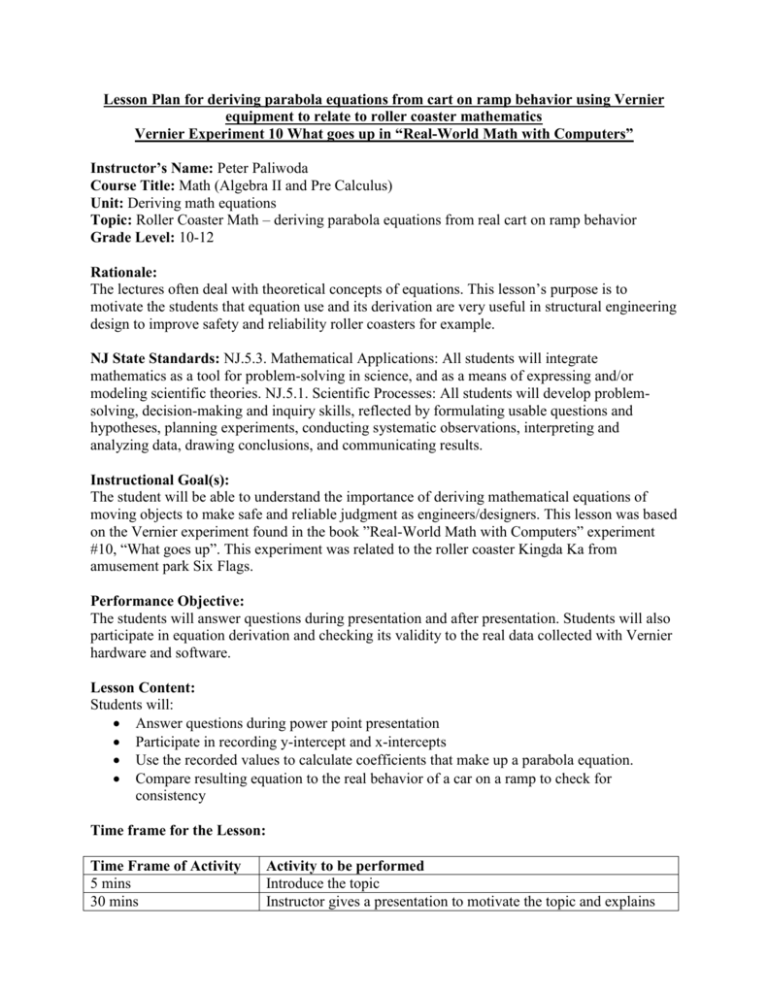
Lesson Plan for deriving parabola equations from cart on ramp behavior using Vernier equipment to relate to roller coaster mathematics Vernier Experiment 10 What goes up in “Real-World Math with Computers” Instructor’s Name: Peter Paliwoda Course Title: Math (Algebra II and Pre Calculus) Unit: Deriving math equations Topic: Roller Coaster Math – deriving parabola equations from real cart on ramp behavior Grade Level: 10-12 Rationale: The lectures often deal with theoretical concepts of equations. This lesson’s purpose is to motivate the students that equation use and its derivation are very useful in structural engineering design to improve safety and reliability roller coasters for example. NJ State Standards: NJ.5.3. Mathematical Applications: All students will integrate mathematics as a tool for problem-solving in science, and as a means of expressing and/or modeling scientific theories. NJ.5.1. Scientific Processes: All students will develop problemsolving, decision-making and inquiry skills, reflected by formulating usable questions and hypotheses, planning experiments, conducting systematic observations, interpreting and analyzing data, drawing conclusions, and communicating results. Instructional Goal(s): The student will be able to understand the importance of deriving mathematical equations of moving objects to make safe and reliable judgment as engineers/designers. This lesson was based on the Vernier experiment found in the book ”Real-World Math with Computers” experiment #10, “What goes up”. This experiment was related to the roller coaster Kingda Ka from amusement park Six Flags. Performance Objective: The students will answer questions during presentation and after presentation. Students will also participate in equation derivation and checking its validity to the real data collected with Vernier hardware and software. Lesson Content: Students will: Answer questions during power point presentation Participate in recording y-intercept and x-intercepts Use the recorded values to calculate coefficients that make up a parabola equation. Compare resulting equation to the real behavior of a car on a ramp to check for consistency Time frame for the Lesson: Time Frame of Activity 5 mins 30 mins Activity to be performed Introduce the topic Instructor gives a presentation to motivate the topic and explains 20 mins 10 mins the equations that will be used. Students participate in calculating the coefficients of a parabola equation Teacher asks “what if” questions to see how well students understood the topic. These questions are listed in the power point presentation Instructional procedures: a. Focusing event –Students will be asked about parabolas. b. Bridge/ Connections – Students will be asked if they were ever on a roller coaster. c. Teaching procedures – After the first half of the presentation, the teacher will emulate the behavior of a roller coaster using a cart on a ramp. The cart will be pushed up the ramp with right amount of force so that the cart goes up, reaches its maximum peak and then come down during which distance data will be collected by a Vernier motion sensor. The collected date should resemble a parabola. Follow the instructions given in exp. 10 of the Vernier book “Real-World Math with Computers”. After data is collected, students will be asked to participate in parabola coefficient calculation that makes up the parabola equation. Their result will be checked across the classroom for consistency and then be plugged back into Logger Pro software running along with Vernier sensors to see if derived equation relates to the graph acquired by motion sensors. d. Formative check – The teacher will be observing for independence of the student to perform the calculations. In addition, the teacher will question students while they are doing the calculation if they have a good understanding of what is being asked of them. For instance, asking them how to solve for the unknowns. e. Student participation- The students will be working individually or in pairs, but the whole effort is done as a whole class. f. Interdisciplinary connections – This activity integrates technology with science. The students will learn to appreciate the ease of data collection. g. Closure- After lab activity, there will be a discussion of the lab results and questions. The teacher brings up the question on importance of roller coaster equation derivation. And ask couple “what if” questions that are included in the power point presentation. Evaluation Procedure: The student evaluations will be done based on in class discussions and correctness of their answers. If majority of the class lacks the understanding of the concepts, the teacher needs to spend more time explaining the topic and slowly re-demonstrating the experiment and its importance. Materials and Aids: The lab will require 1 PC or laptop with LoggerPro software installed on it, logger pro hardware unit that connects the motion sensor, power supply for logger pro unit, 1 motion sensor and a Vernier ramp with a cart. Printed exp. 10 from “Real-World Math with Computers” is also handy to have during the presentation.

